Living in a compact bedroom doesn’t mean sacrificing style or comfort. Whether you’re dealing with a studio apartment, a converted attic space, or simply a smaller bedroom in your home, the right design strategies can transform your cramped quarters into a surprisingly spacious retreat that feels both functional and inviting.
The secret lies in understanding how to work with your space rather than against it. By implementing clever storage solutions, choosing the right color palette, and selecting furniture that serves multiple purposes, you can create an environment that feels larger and enhances your daily living experience. From strategic lighting placement to innovative storage hacks, these design principles will help you maximize every square foot while maintaining the cozy atmosphere that makes a bedroom truly special.
In this comprehensive guide, we’ll explore twenty-five proven strategies that interior designers and space optimization experts swear by. These aren’t just theoretical concepts—they’re practical, actionable ideas that have been tested in real-world small spaces with remarkable results. Whether you’re starting from scratch or looking to refresh your current setup, these techniques will help you create a bedroom that defies its physical limitations.
Essential Strategies for Small Bedroom Design:
Smart Furniture Selection Choose multi-functional pieces like storage ottomans, beds with built-in drawers, and foldable workstations.
Strategic Storage Solutions Use wall-mounted shelving and tall storage units to maximize vertical space and eliminate clutter.
Color Psychology and Light Management Apply lighter colors, strategic mirror placement, and layered lighting to create spaciousness.
Textural Elements and Personal Touches Add warmth through fabrics and patterns while maintaining a clean, uncluttered look.
Natural Elements and Air Quality Incorporate plants to improve air quality and add life without taking up floor space.
1. Invest in Versatile, Multi-Purpose Furniture
The cornerstone of effective small bedroom design lies in choosing furniture pieces that work overtime. A bed frame with integrated storage drawers eliminates the need for a separate dresser while keeping your linens and clothing organized. Consider using a compact writing desk that can also serve as a vanity, or choose an ottoman that offers both seating and hidden storage for seasonal items.
Look for pieces that can be easily reconfigured or moved as your needs change. Folding chairs can be stored flat against walls when not in use, while nesting tables provide surface space when needed but tuck away neatly otherwise. This flexibility ensures your bedroom can adapt to different activities throughout the day without feeling cramped or cluttered.
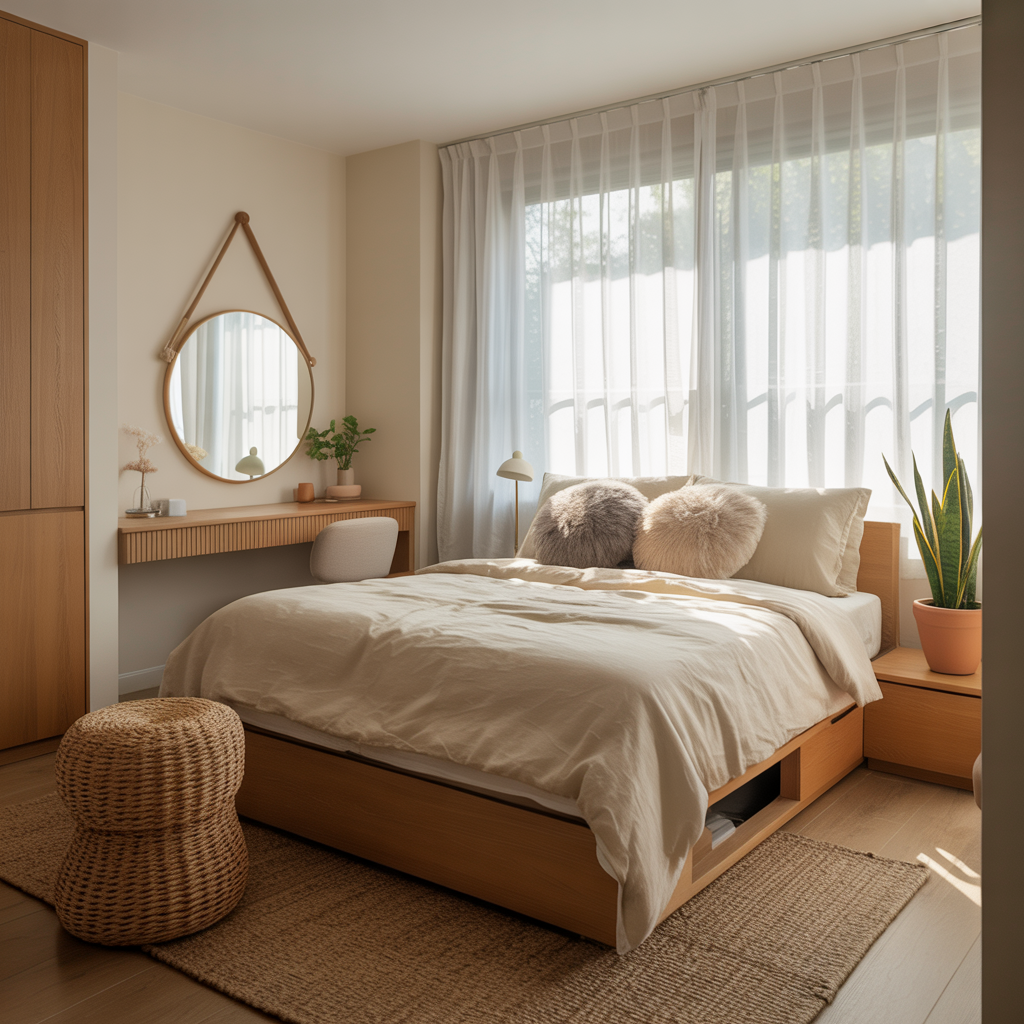
2. Harness the Power of Light-Reflecting colors.
Transform your bedroom’s atmosphere by embracing a palette of soft, light-reflecting hues. Gentle ivory tones, whisper-soft grays, and barely-there pastels work together to create an expansive feeling that makes your walls seem to disappear. These colors don’t absorb light like darker shades do instead, they bounce natural and artificial light around your room, creating a bright, airy environment.
Consider painting your ceiling a shade lighter than your walls to add height to your space. This technique tricks the eye into perceiving more vertical space than actually exists. Even your bedding and curtains should follow this light color principle, contributing to the overall sense of openness and tranquility.
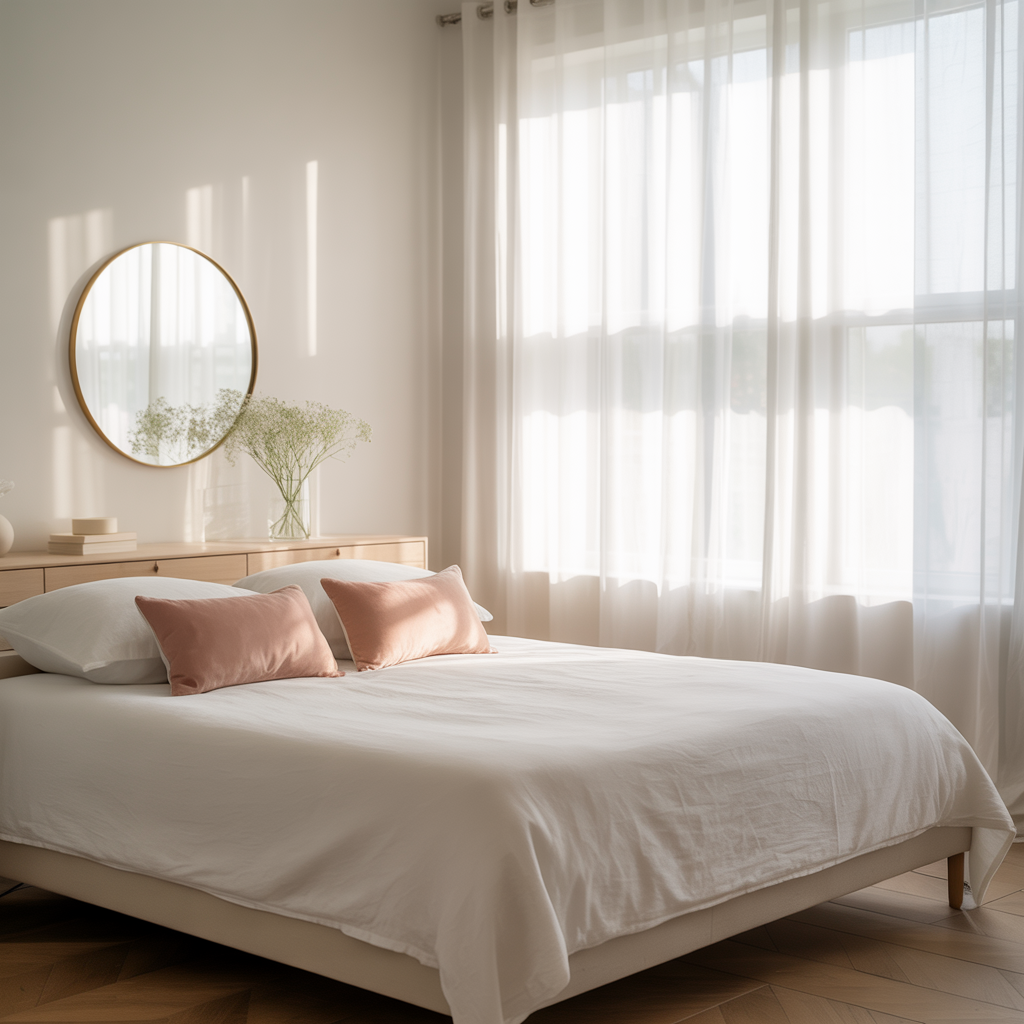
3. Create Depth and Dimension with Strategic Mirror placement.
Mirrors are perhaps the most powerful tool in a small bedroom designer’s arsenal. A large mirror positioned opposite a window will capture and reflect natural light throughout your space, instantly brightening even the darkest corners. The reflection also creates the illusion that your room extends beyond its actual boundaries.
Consider creating a mirrored accent wall or using multiple smaller mirrors arranged in an artistic pattern. Mirrored closet doors serve a dual purpose, providing necessary reflection while hiding storage areas. Even mirrored furniture pieces, like a reflective nightstand or dresser, contribute to the overall sense of spaciousness without overwhelming your design scheme.
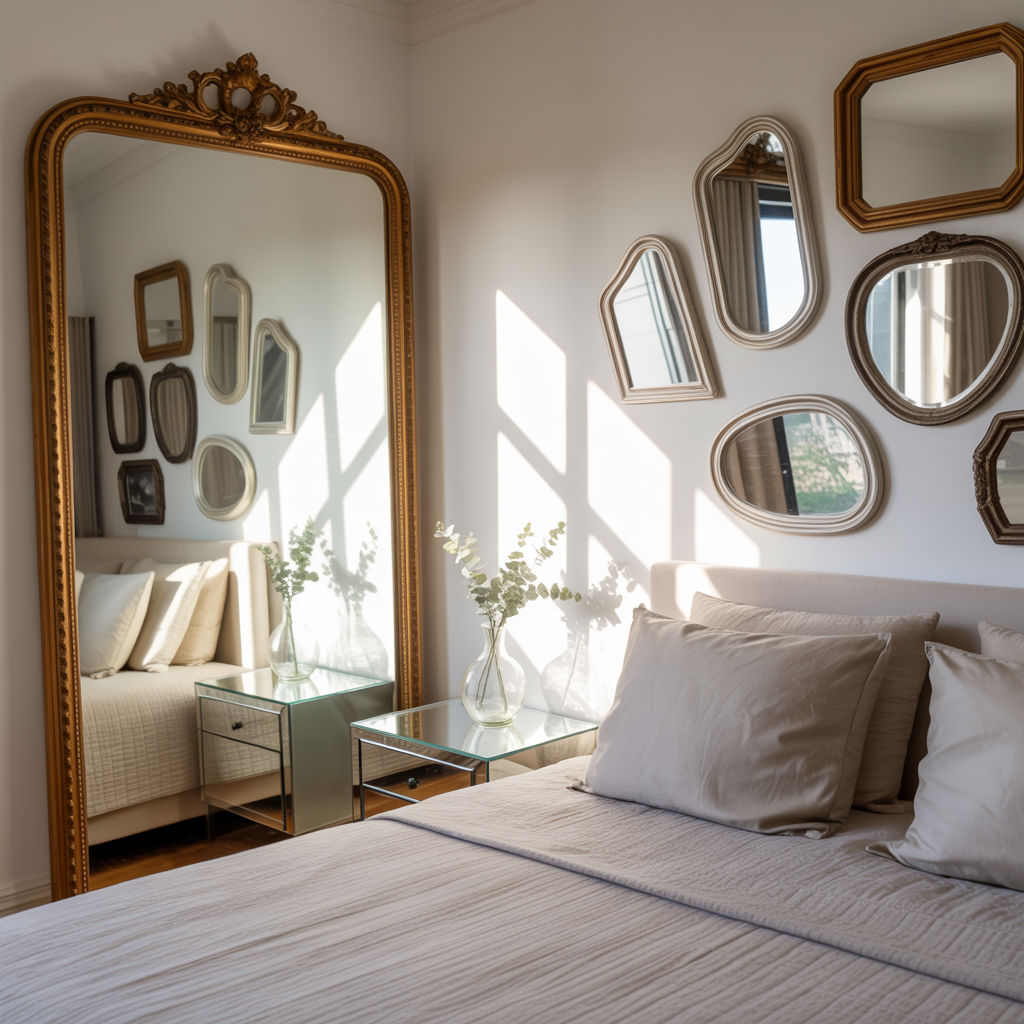
4. Exploit Every Inch of Vertical Real Estate
Most people focus on floor space and forget about the valuable territory above eye level. Tall, narrow bookcases draw attention upward while providing ample storage for books, decorative objects, and personal items. Wall-mounted shelving systems can be customized to fit awkward spaces and unusual wall configurations.
Install hooks and hanging organizers on walls and behind doors to keep frequently used items accessible but off surfaces. A pegboard system can hold everything from jewelry to bags while adding an intriguing textural element to your wall. The key is to think of your walls as valuable storage real estate that’s currently underutilized.
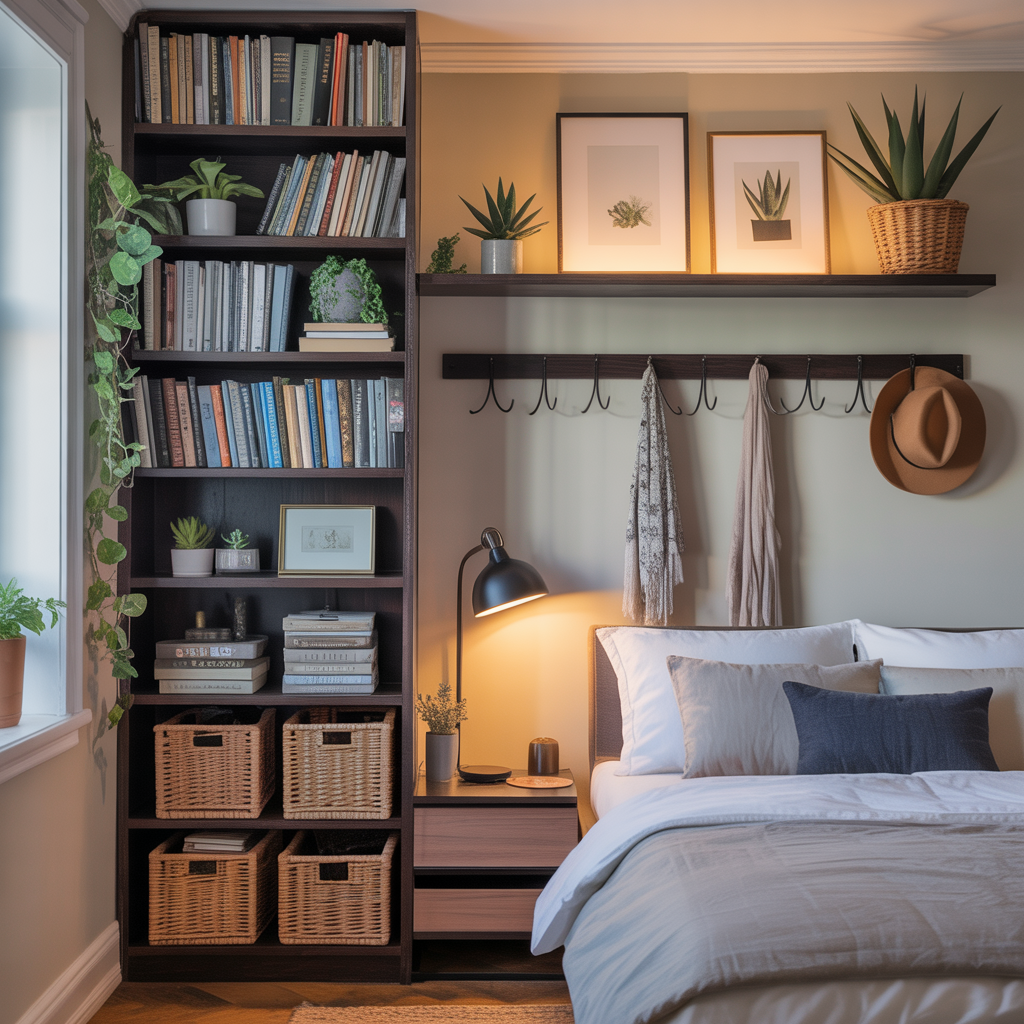
5. Elevate Your Sleep Space with a Loft Design
Raising your bed creates an entirely new functional area underneath essentially doubling your usable floor space. The area beneath a lofted bed can accommodate a cozy reading nook, a compact workspace, or additional storage solutions. This approach works particularly well in rooms with high ceilings, where the vertical space would otherwise go unused.
Choose a loft bed with built-in features like a desk or shelving to maximize the efficiency of this elevated approach. Ensure you have adequate headroom both above and below the bed for comfortable use. This solution is particularly effective for studio apartments where the bedroom area needs to serve multiple functions throughout the day.
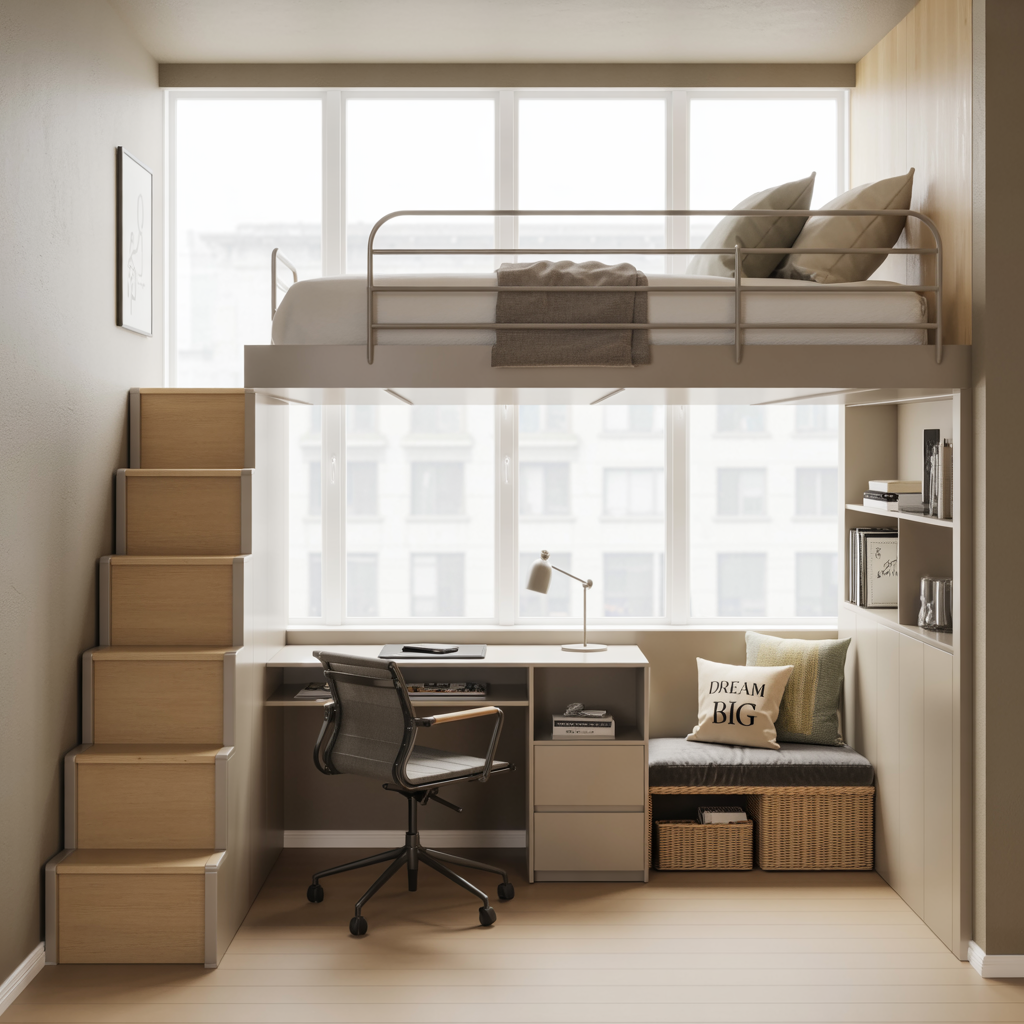
6. Maximize Hidden Storage Opportunities
The space beneath your bed represents a significant storage opportunity that many people overlook. Rolling storage containers, vacuum-sealed bags for seasonal clothing, and pull-out drawers can transform this dead space into a highly functional storage area. Choose containers with wheels for easy access, and consider clear or labeled options for quick identification.
Under-bed storage works best when it’s organized by category and frequency of use. Keep everyday items toward the front for quick access, while seasonal or rarely used items can be stored toward the back. This approach keeps your belongings organized and accessible without cluttering your visible living space.
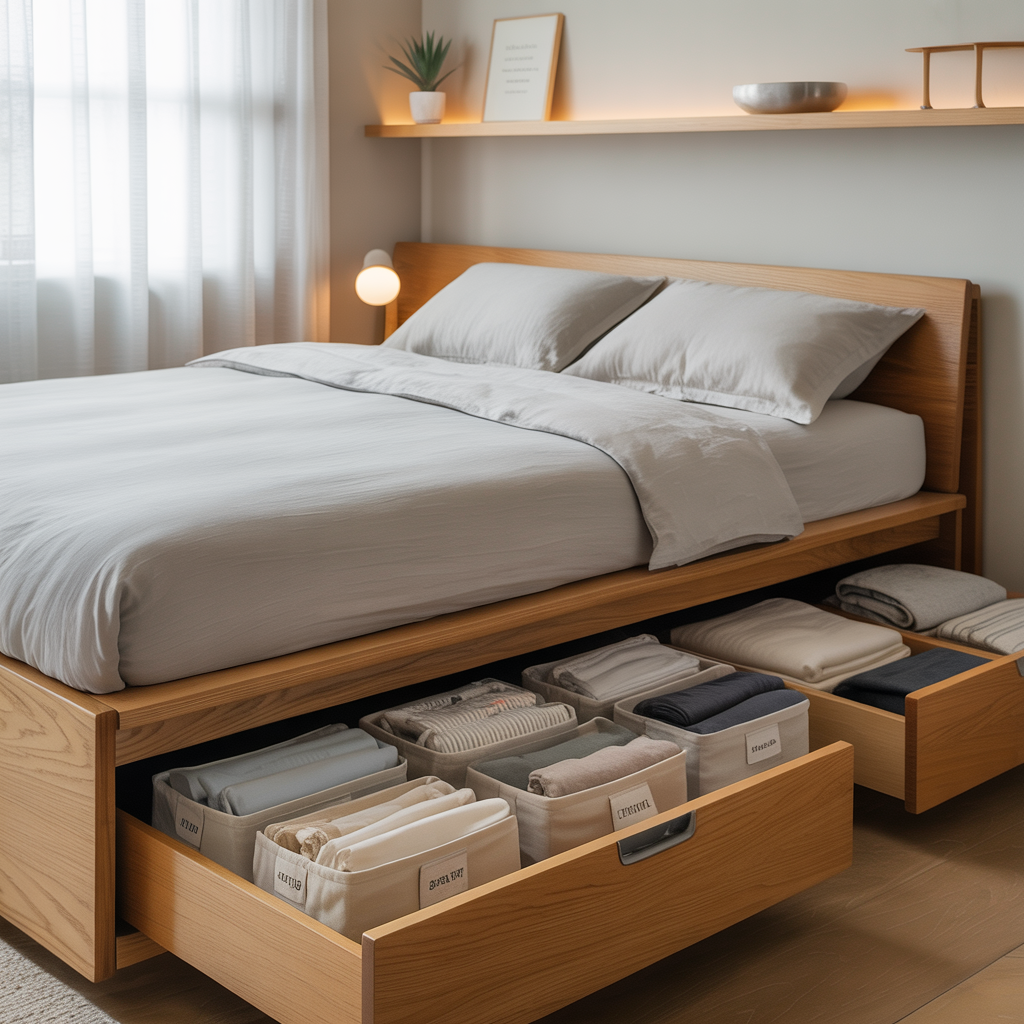
7. Implement Space-Saving Desk Solutions
A wall-mounted folding desk provides a dedicated workspace that disappears when not needed. These ingenious solutions fold flat against the wall, reclaiming valuable floor space for other activities. When extended, they provide ample room for a laptop, documents, and desk accessories.
Look for models with built-in storage compartments or shelving to keep work supplies organized. Some designs include fold-down supports that create a surprisingly sturdy work surface. This type of desk is perfect for bedrooms that need to accommodate both rest and productivity without permanent space dedication.
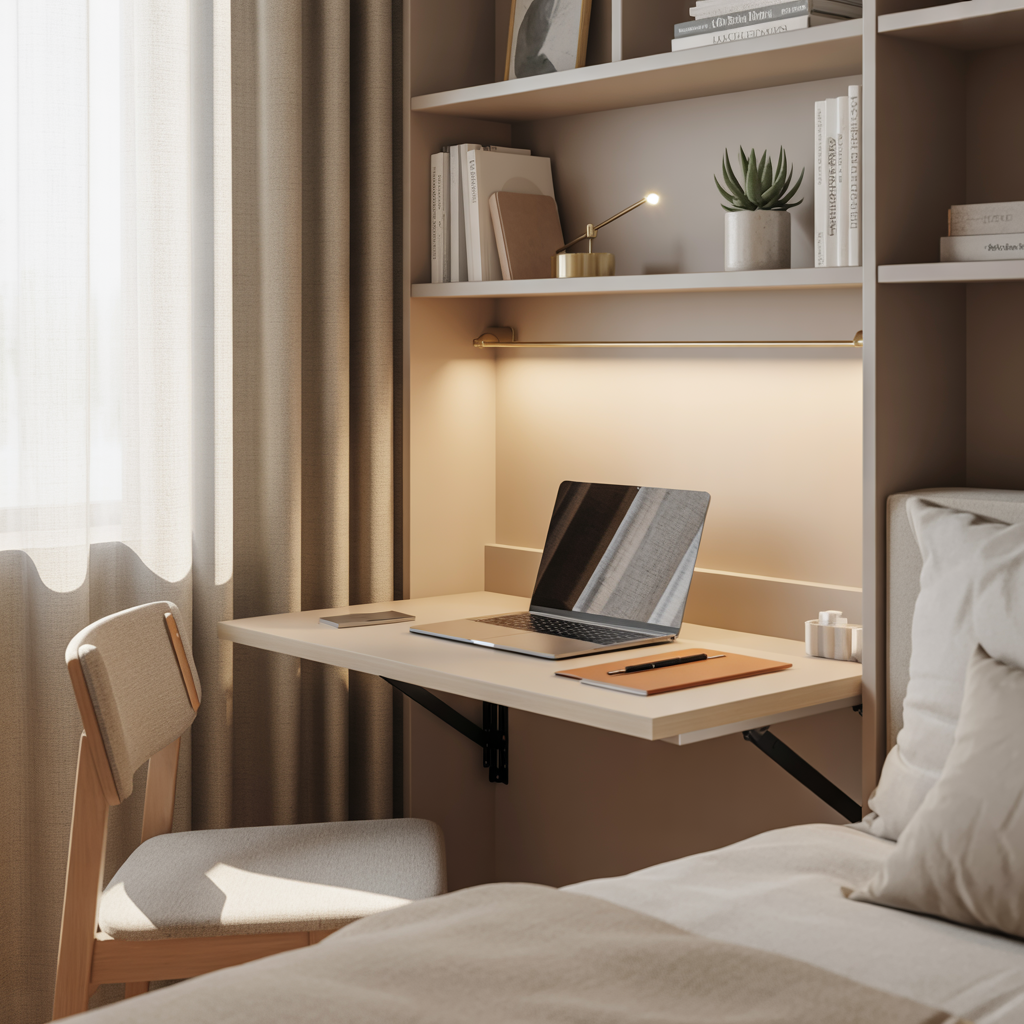
8. Add storage without a visual weight.
Floating shelves create storage and display opportunities without the visual bulk of traditional furniture pieces. These sleek, minimalist shelves appear to hover on your walls, creating clean lines that don’t interrupt your room’s flow. They’re perfect for displaying books, plants, artwork, or personal collections.
Install floating shelves at varying heights to create visual interest while maximizing storage capacity. Group items in odd numbers for the most pleasing arrangement, and mix functional storage with decorative elements. The key is maintaining balance—enough items to make the shelves useful, but not so many that they appear cluttered.
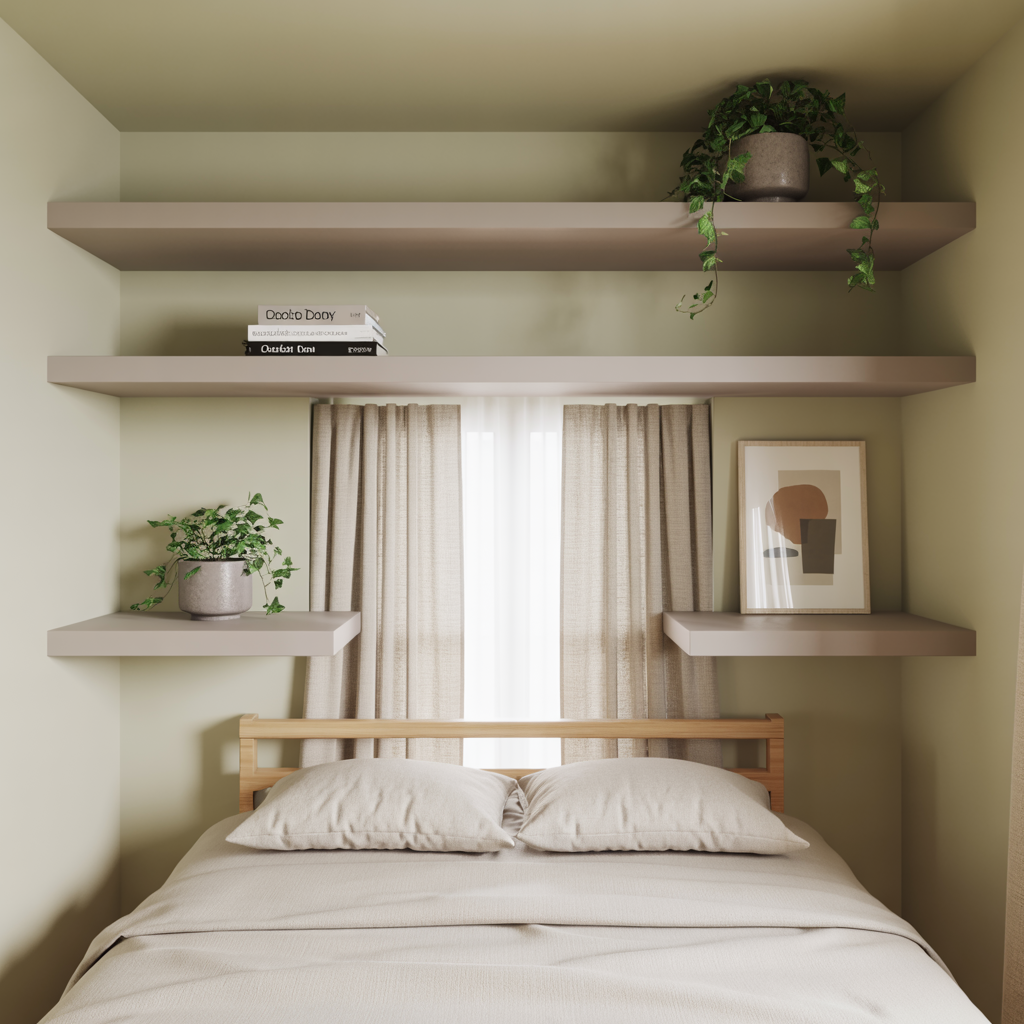
9. Design an Eye-Catching Display Wall
A thoughtfully curated gallery wall draws attention upward while showcasing your personality and interests. Mix different sizes of artwork, photographs, and decorative objects to create visual movement that makes your ceiling appear higher. This technique adds character and focal interest without requiring any floor space.
Plan your gallery wall layout on paper first, or cut paper templates to experiment with arrangements before making holes in your wall. Include a mix of framed pieces, small shelves with objects, and even floating plants to create dimension and interest. The goal is creating a cohesive look that reflects your style while contributing to the room’s sense of height.
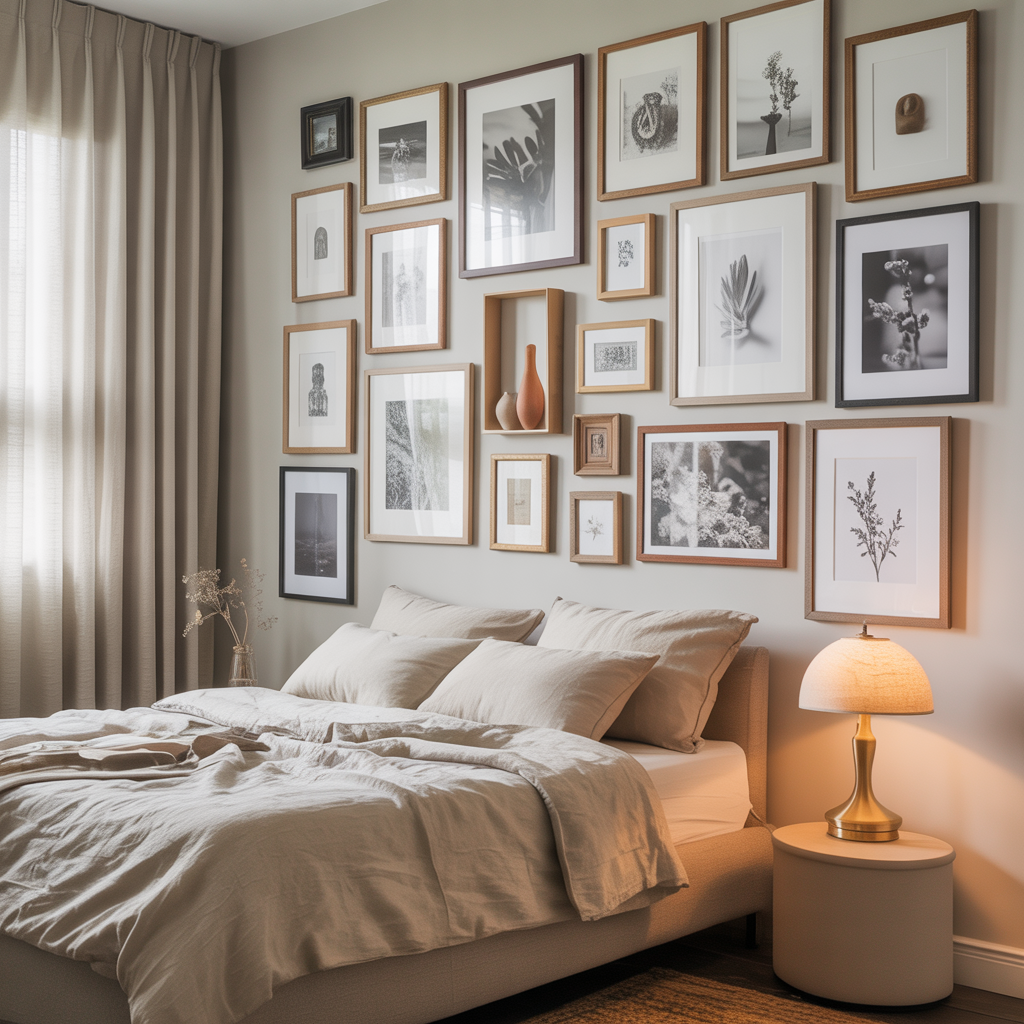
10. Streamline Traffic Flow with Sliding Elements
Traditional hinged doors require clearance space that can be better utilized in small bedrooms. Sliding doors, whether for closets or room entrances, eliminate this wasted space while creating cleaner sight lines. Barn-style sliding doors add rustic charm, while modern track systems offer sleek, contemporary aesthetics.
Consider pocket doors that slide completely into the wall cavity or barn doors that slide along an exterior track. These solutions work particularly well for closets, where the door would otherwise swing into your limited floor space. The smooth operation and space-saving design make sliding doors both practical and stylish choices.
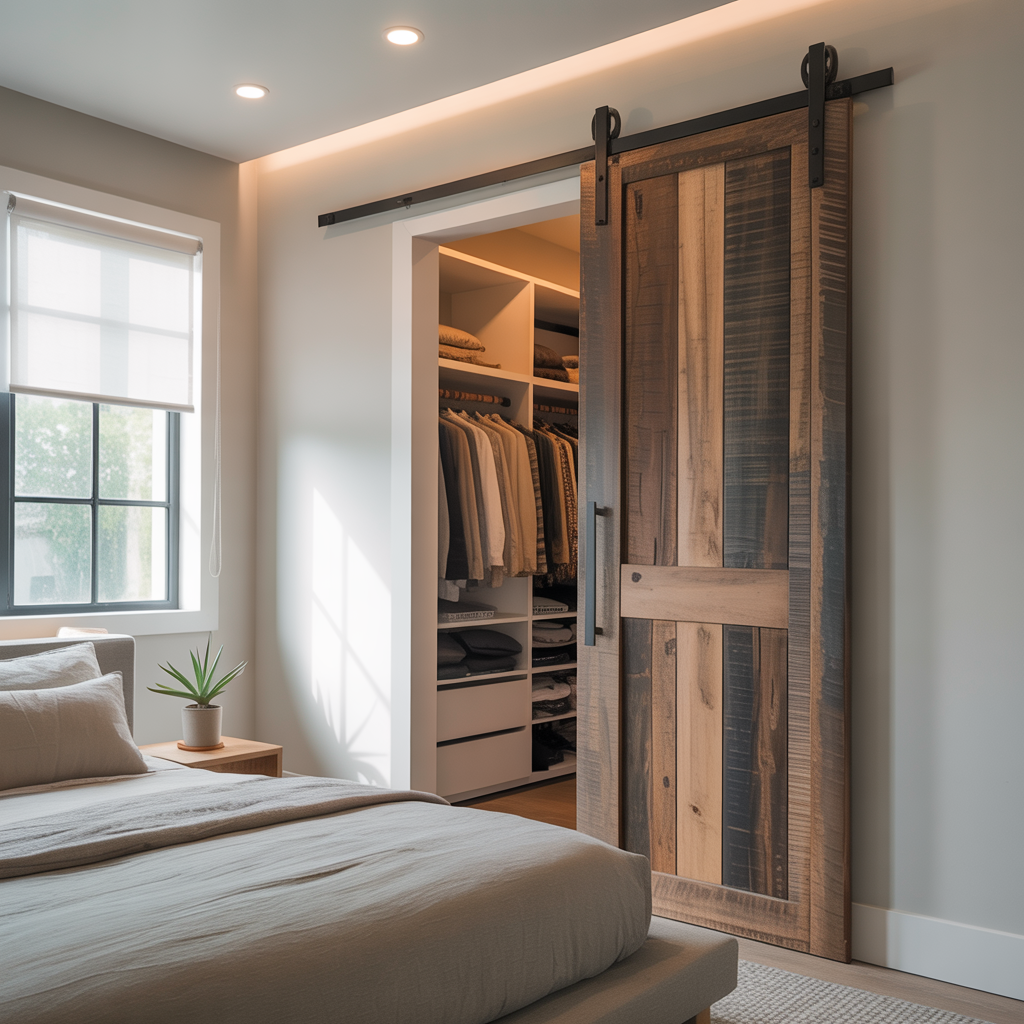
11. Choose Transparent Furniture for Visual lightness.
Clear acrylic or glass furniture pieces provide functionality without visual weight. A transparent desk chair, side table, or even a clear storage unit allows light to pass through, maintaining the open feeling of your space. These pieces seem to disappear into the background while still providing necessary function.
Acrylic furniture works particularly well in modern or minimalist bedroom designs, where clean lines and uncluttered aesthetics are priorities. These pieces are often more durable than they appear and can support significant weight while maintaining their invisible presence in your room’s design scheme.
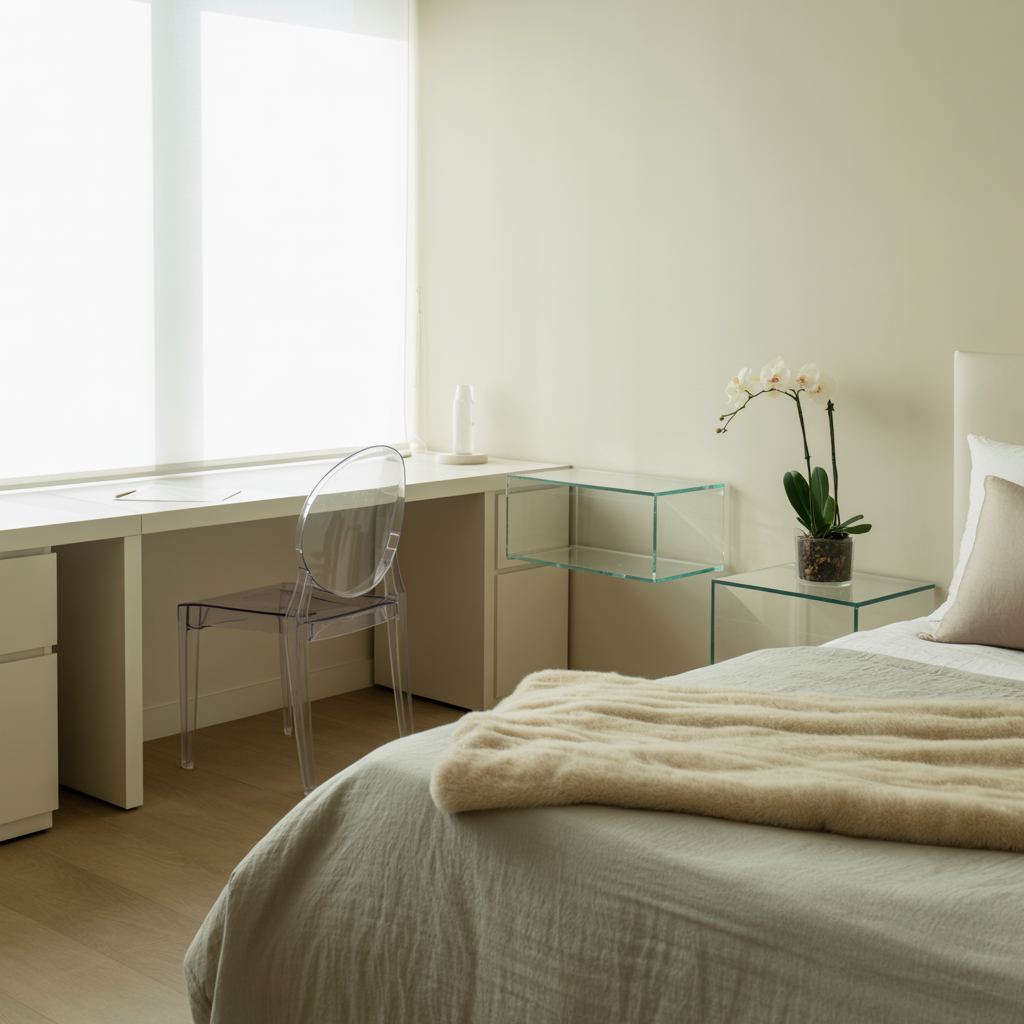
12. Maximize Seating with a Daybed Approach
A daybed serves dual purposes as both a sleeping space and a comfortable seating area. During the day, it functions as a sofa for reading, relaxing, or entertaining guests. At night, it provides a comfortable sleeping surface. This versatility makes it an excellent choice for studio apartments or bedrooms that need to accommodate multiple functions.
Style your daybed with plenty of pillows and throws to enhance its sofa-like appearance during daytime hours. Choose fabrics and colors that complement your overall design scheme while providing comfort for both sitting and sleeping. A daybed with a trundle underneath can even accommodate overnight guests without permanent space dedication.
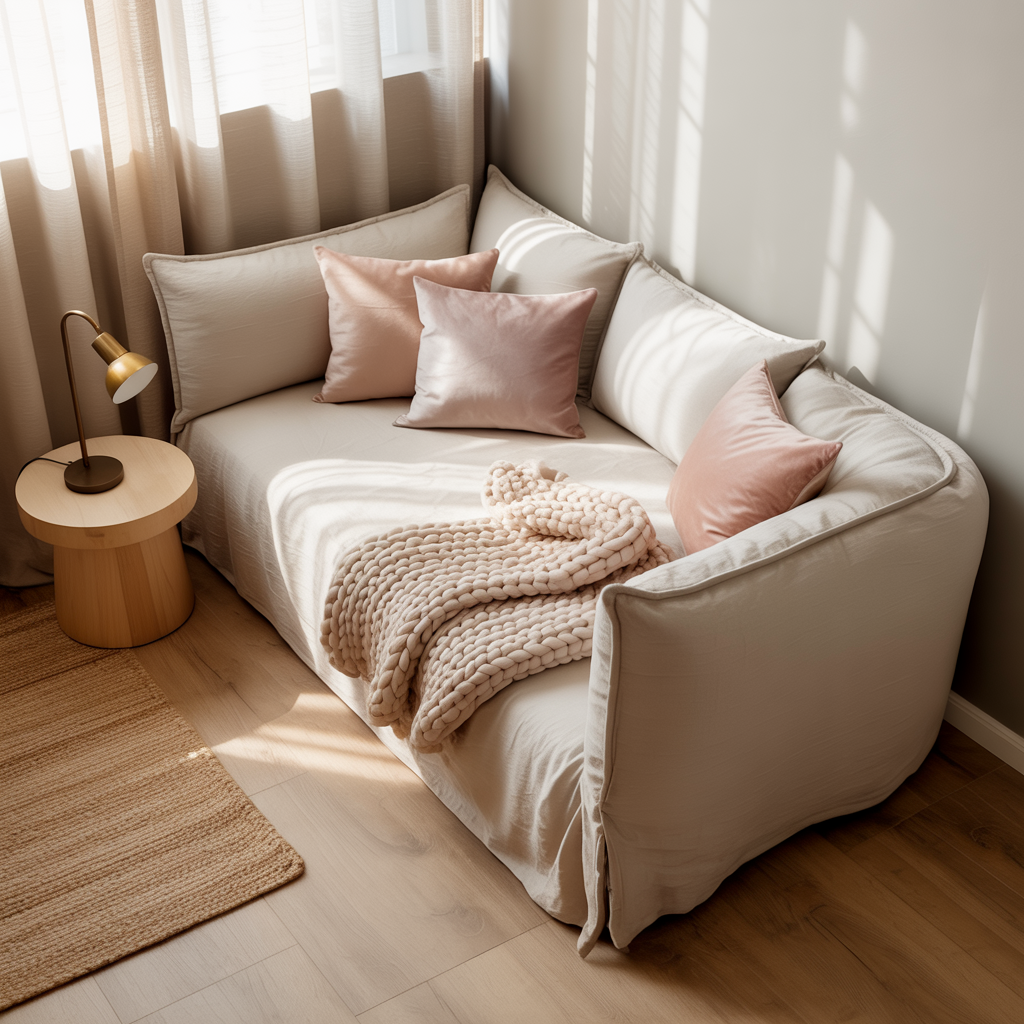
13. Optimize Clothing Storage Efficiency
A well-designed compact wardrobe can hold significantly more clothing than traditional closets when properly organized. Look for wardrobes with adjustable shelving, multiple hanging rods at different heights, and built-in drawer systems. Sliding doors save space compared to hinged alternatives.
Maximize your wardrobe’s efficiency with space-saving hangers, shelf dividers, and hanging organizers. Vertical storage solutions like cascading hangers and multi-level shoe racks help you utilize every inch of available space. The key is creating designated spots for different types of clothing and accessories.
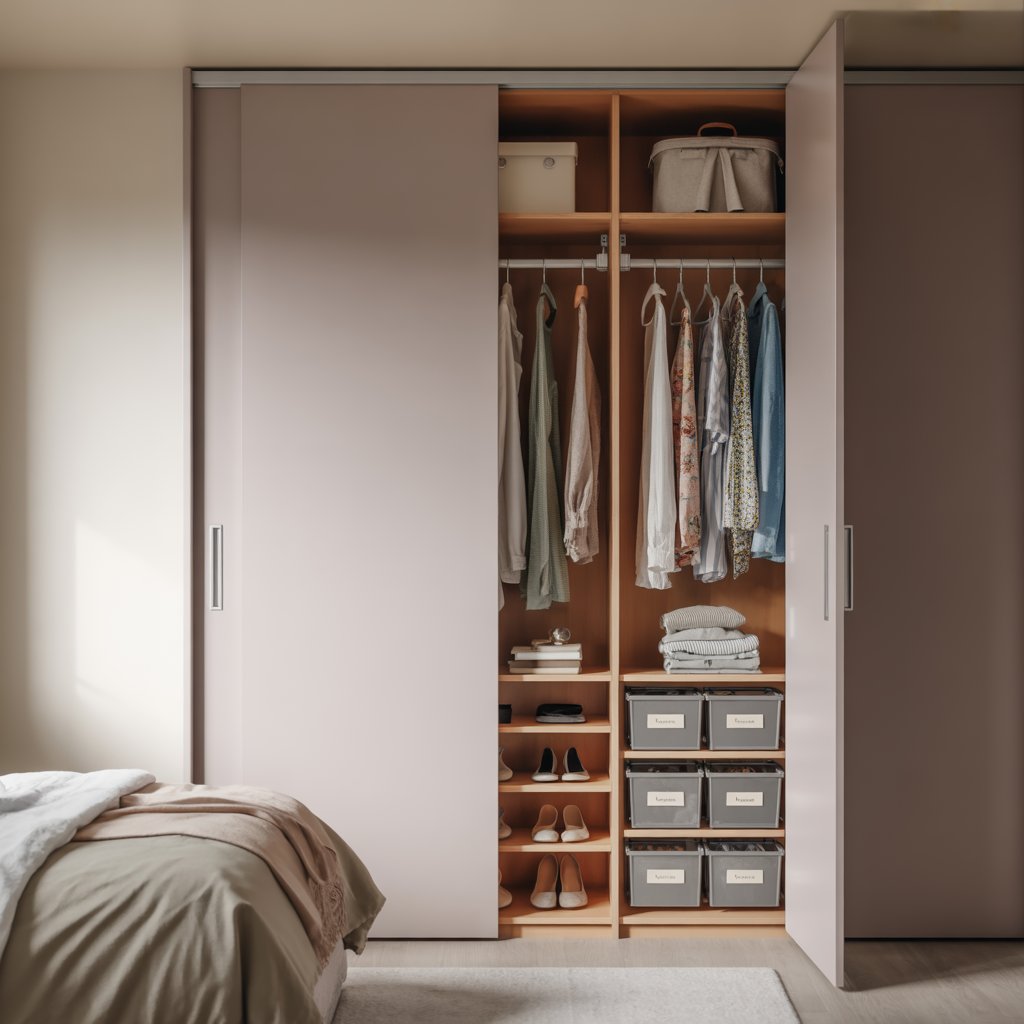
14. Integrate Storage into Your Room’s Architecture
Built-in storage solutions create a custom, finished look while maximizing every available inch. A headboard with integrated shelving provides bedside storage without requiring separate nightstands. Built-in window seats offer seating and storage while taking advantage of often-underutilized architectural features.
Consider having custom storage built around existing architectural elements like alcoves, awkward corners, or sloped ceilings. These solutions often cost more initially but provide superior storage capacity and a high-end, integrated appearance that enhances your room’s overall value and functionality.
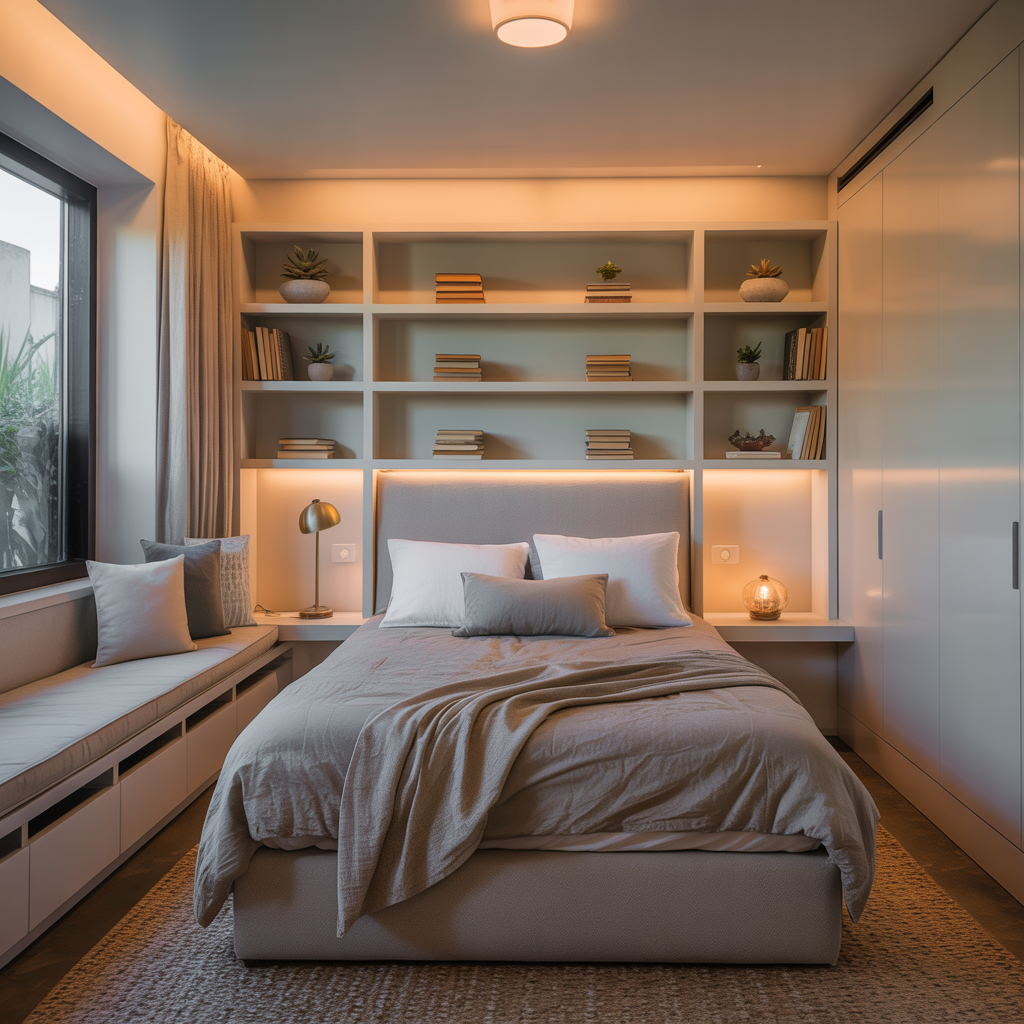
15. Transform Your Room with a Wall Bed
A Murphy bed represents the ultimate space-saving solution, folding completely against the wall when not in use. Modern wall beds are far more sophisticated than their predecessors, offering easy operation and attractive designs that complement contemporary interiors. Some models include integrated desks or shelving that remain accessible even when the bed is folded up.
This solution works particularly well in studio apartments or multi-purpose rooms where floor space is at an absolute premium. During the day, your bedroom can serve as a home office, exercise area, or entertainment space. The transformation is dramatic and instantly doubles your usable floor area.
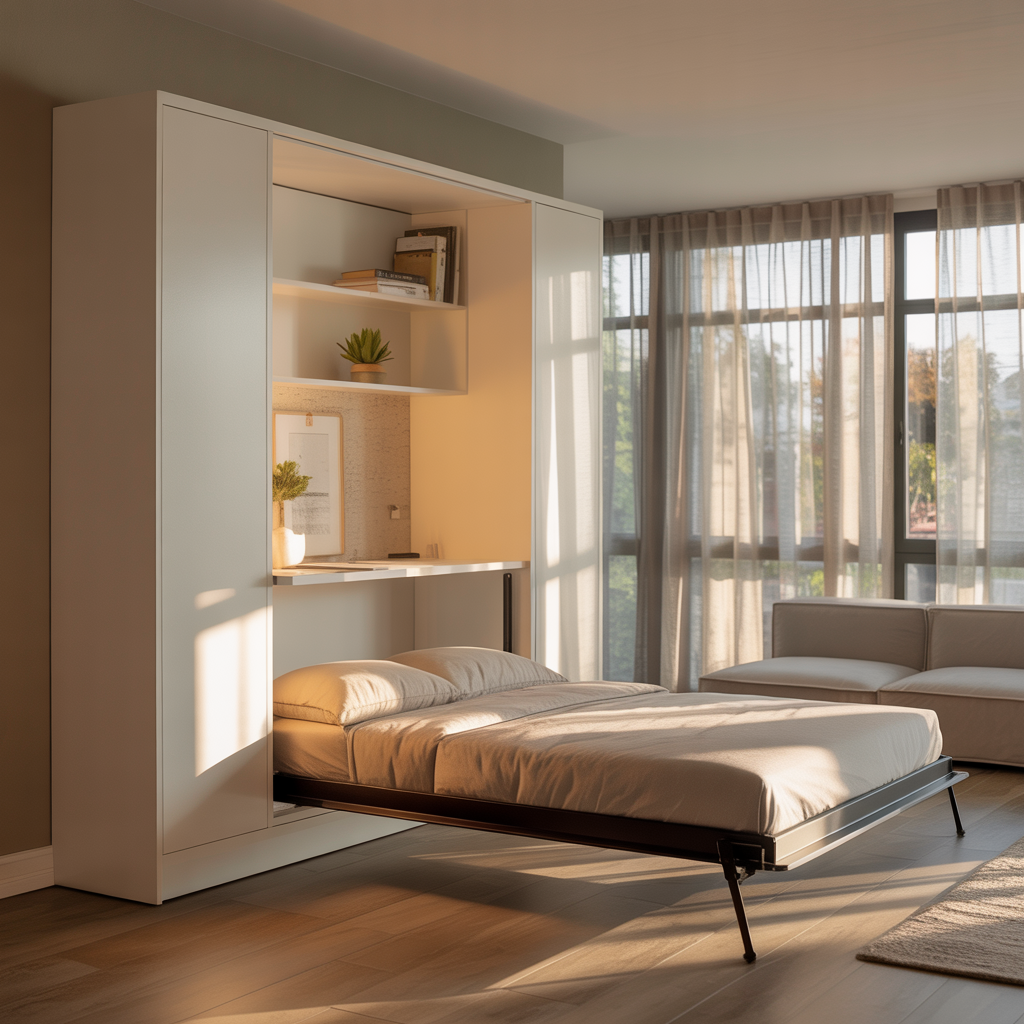
16. Select Proportionate Bedside Solutions.
Instead of bulky traditional nightstands, choose narrow alternatives that provide essential functions without overwhelming your space. A slim console table, floating shelf, or even a small stool can hold your bedside essentials while maintaining clean sight lines around your bed.
Look for nightstands with built-in charging stations, small drawers, or open shelving to maximize functionality. Wall-mounted options free up floor space entirely while still providing surface area for lamps, books, and personal items. The key is choosing pieces that scale appropriately with your room size and bed dimensions.
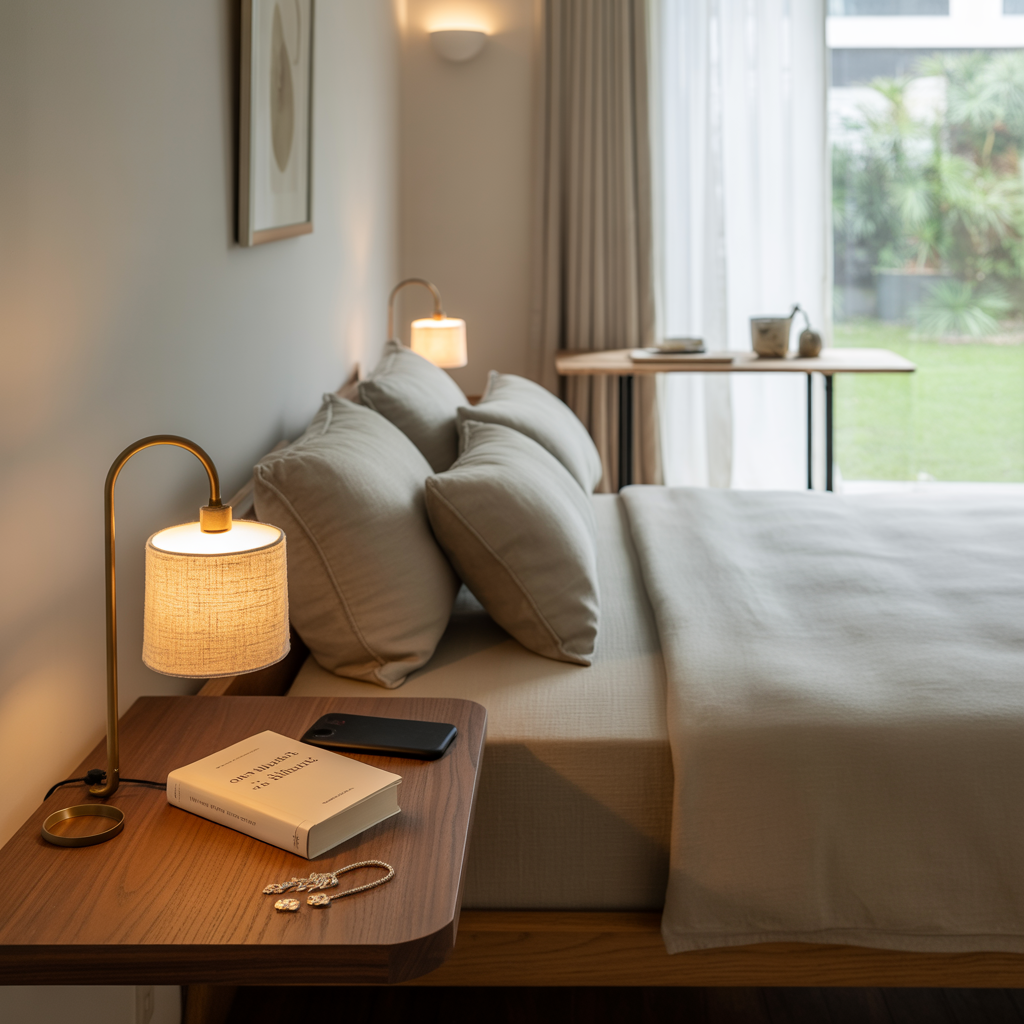
17. Layer Textures for Visual Richness
Adding depth through varied textures creates interest and warmth without requiring additional space. Combine smooth cotton sheets with chunky knit throws, or pair sleek modern furniture with rough natural elements like jute rugs or woven baskets. These contrasts create visual complexity that makes your space feel more sophisticated and complete.
Focus on incorporating textures through items you already need—bedding, window treatments, rugs, and decorative pillows. This approach adds personality and comfort while maintaining the clean, uncluttered aesthetic that makes small spaces feel larger. The layering should feel intentional rather than accidental.
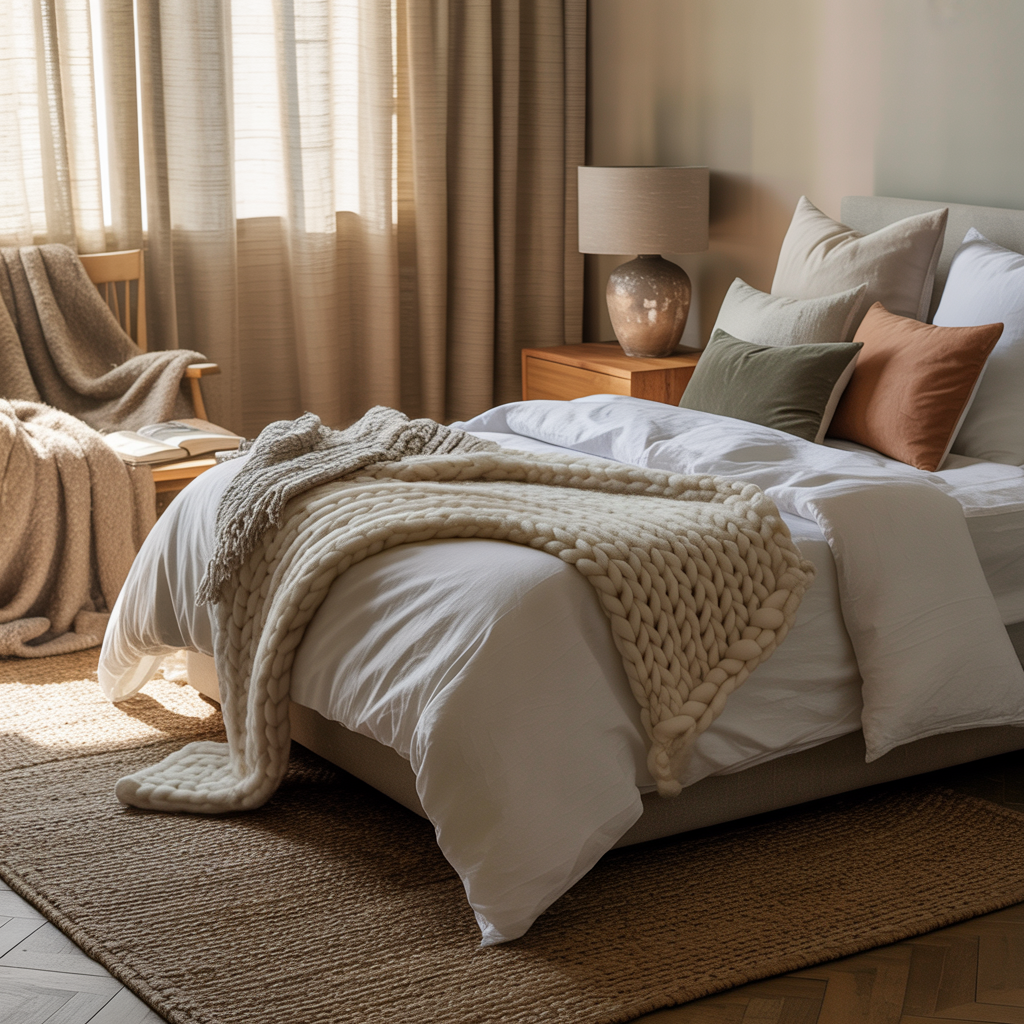
18. Maximize Corner Efficiency
Corners often represent wasted space in small bedrooms, but a well-chosen corner desk can transform this dead area into a productive workspace. Corner desks make efficient use of two walls while leaving the center of your room open and unobstructed. Many models include built-in storage or can be paired with corner shelving units.
Consider the corner’s relationship to natural light sources and electrical outlets when planning your setup. A corner workspace near a window provides pleasant natural light for daytime activities, while proximity to outlets eliminates the need for extension cords that can create visual clutter.
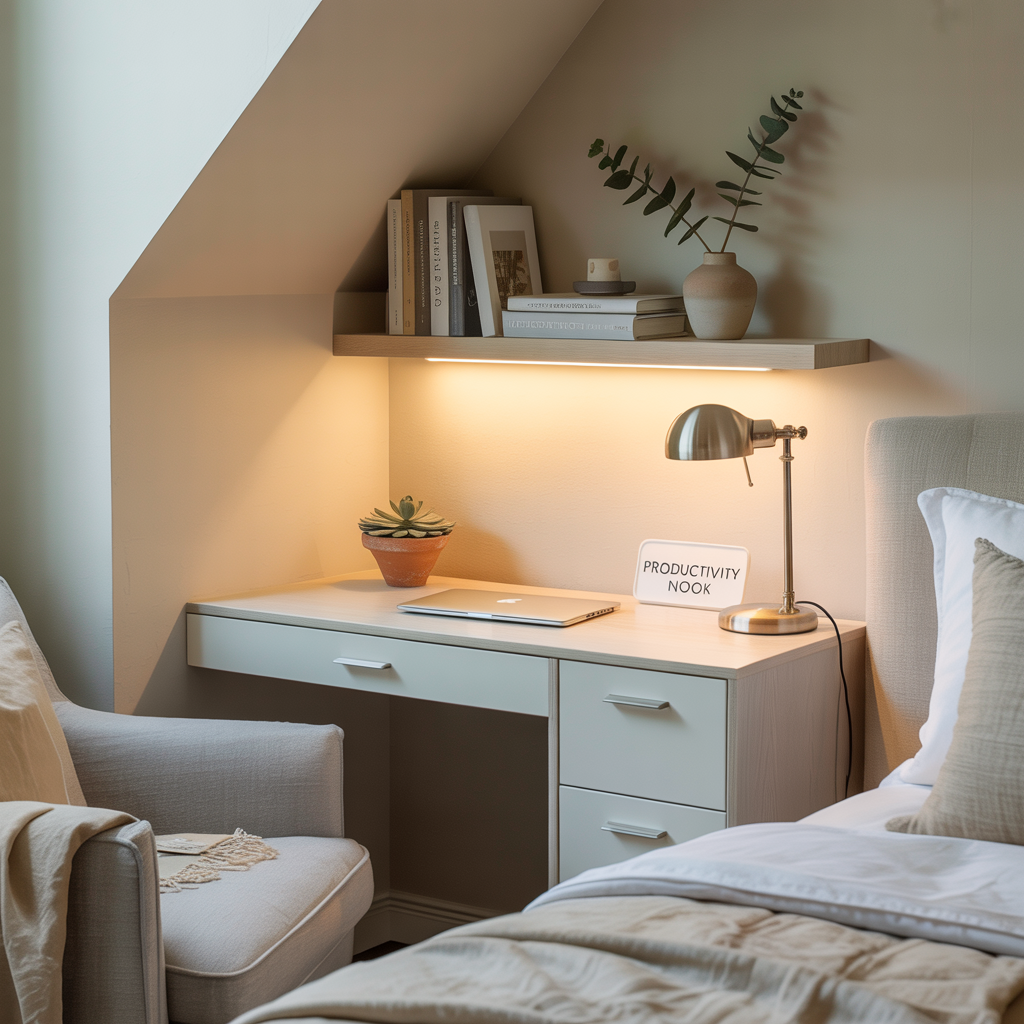
19. Create Height with Window Treatment Tricks
Hanging curtains close to the ceiling and extending them beyond your window’s actual width creates the illusion of larger windows and higher ceilings. This simple trick draws the eye upward while making your windows appear more substantial than they actually are. Choose light-colored fabrics that allow natural light to filter through even when closed.
Consider floor-to-ceiling curtains even for shorter windows, as the continuous vertical lines create an impression of height. The extra fabric pooling at the floor adds elegance while contributing to the overall sense of spaciousness. This technique works with any window size or style.
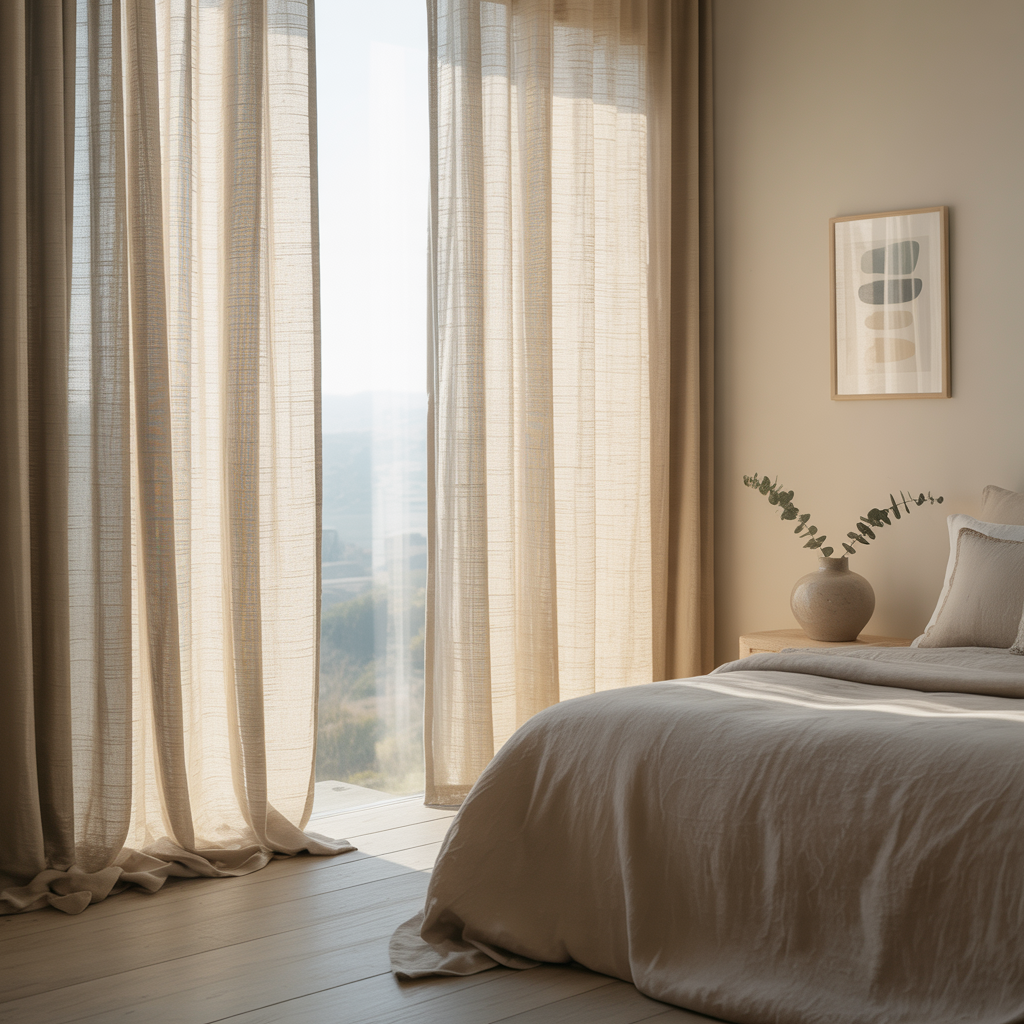
20. Define Areas with Strategic Rug Placement
A well-chosen area rug can make your bedroom feel larger by defining the sleeping area and creating visual boundaries. Choose a rug large enough to extend beyond your bed on at least three sides, as tiny rugs can make a space feel smaller. Light colors and simple patterns work best for creating an expansive feeling.
The rug also adds warmth and softness underfoot while providing an opportunity to introduce colour or pattern into your design scheme. Consider the rug as an anchor for your room’s colour palette, choosing complementary shades that tie your design elements together harmoniously.
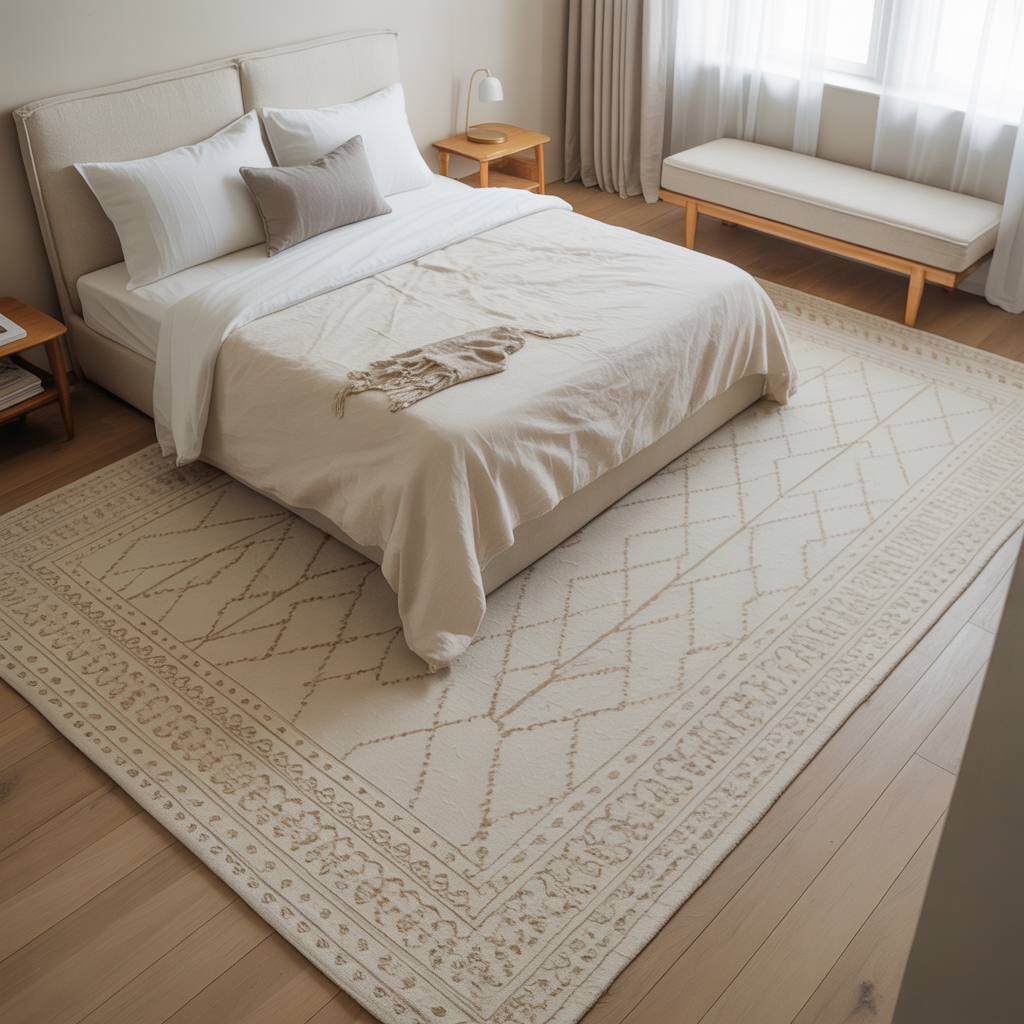
21. Embrace Minimalist Decoration Principles
Restraint in decorating allows the items you do choose to have maximum impact. Select a few high-quality decorative pieces rather than filling every surface with objects. Each item should serve a purpose or bring significant joy, contributing to your room’s overall aesthetic without creating visual clutter.
Focus on items that serve multiple purposes a beautiful bowl that holds jewelry, an attractive basket for storage, or artwork that also provides inspiration. This approach creates a serene, spa-like atmosphere that feels intentional and sophisticated rather than sparse or incomplete.
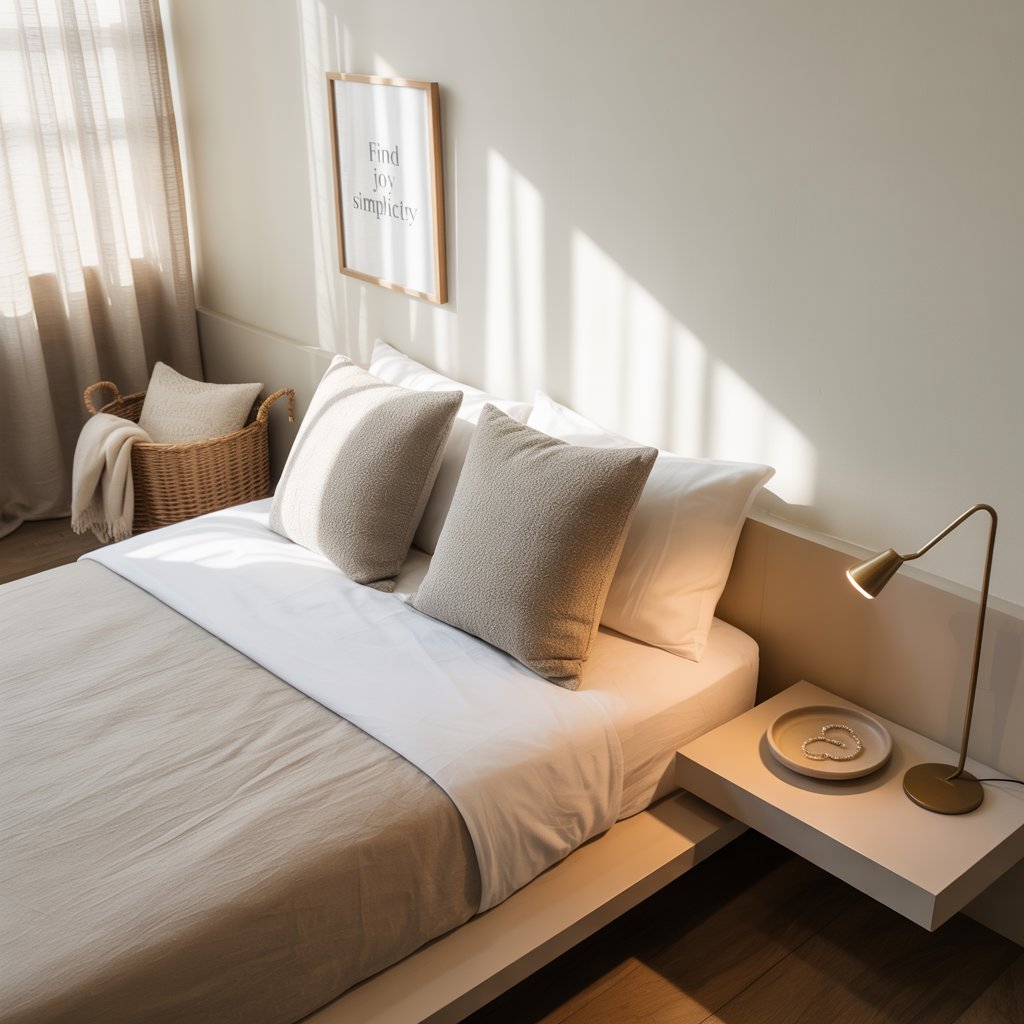
22. Illuminate Without Floor Intrusion
Wall-mounted lighting fixtures free up valuable bedside table space while providing necessary illumination. Swing-arm sconces offer adjustable task lighting for reading, while uplighting fixtures bounce light off the ceiling to create ambient illumination that makes your room feel larger and more open.
Consider installing dimmer switches to control lighting levels throughout the day. Bright light makes spaces feel larger during active hours, while softer lighting creates intimacy for relaxation. Multiple light sources at different levels add depth and dimension to your room’s atmosphere.
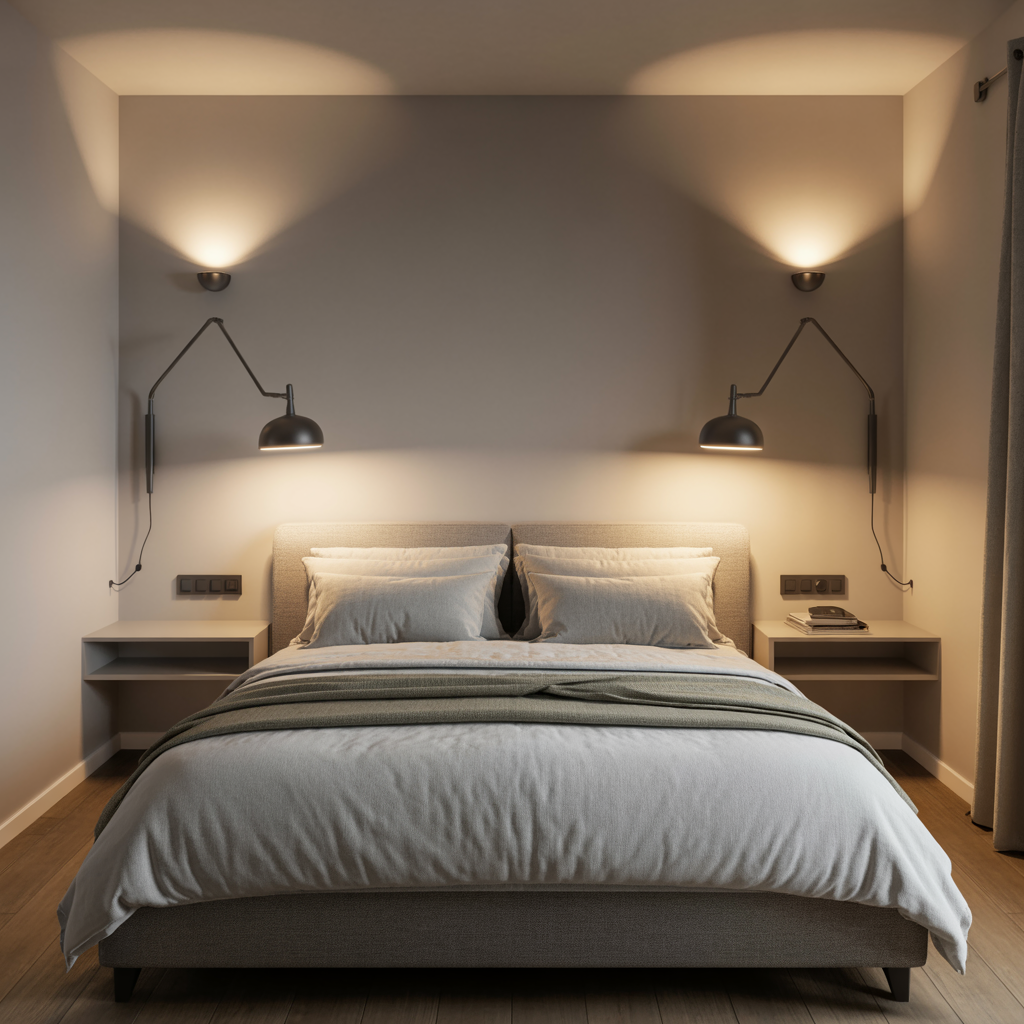
23. Introduce Life with Strategic Greenery
Plants improve air quality while adding natural beauty to your bedroom environment. Choose low-maintenance varieties that thrive in bedroom conditions. Pothos, snake plants, or small succulents work well in various lighting conditions. Hanging planters and wall-mounted plant holders save floor space while adding vertical interest.
Select plants that complement your room’s style and color scheme. Green foliage provides a natural contrast to light-colored walls, while flowering plants can introduce subtle color accents. The key is choosing plants you can successfully maintain, as healthy plants contribute to your room’s vitality while struggling plants detract from the overall atmosphere.
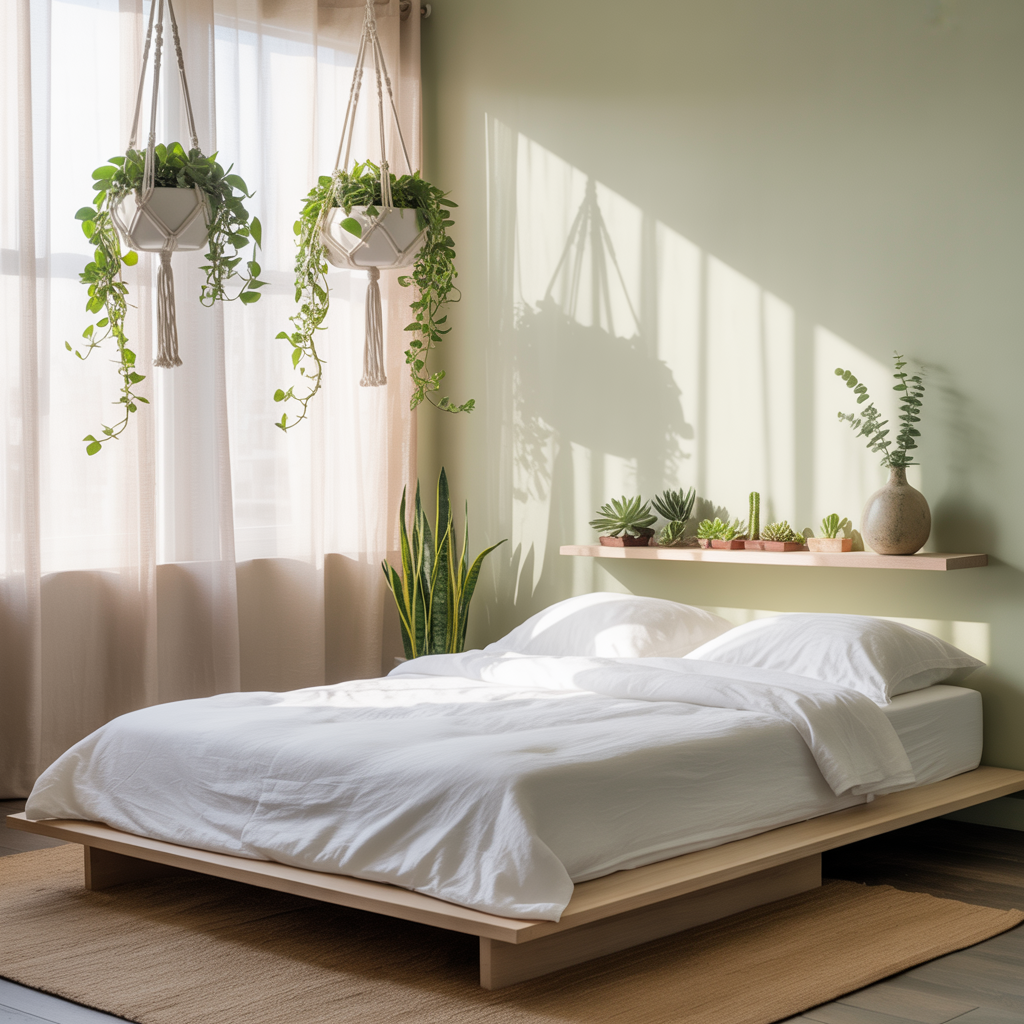
24. Create Functional Zones with Thoughtful Planning
Even in the smallest bedroom, you can create distinct areas for different activities using area rugs, lighting, and furniture arrangement. A small rug can define a reading corner, while a different rug anchors your sleeping area. This zoning approach makes your room feel more complex and functional despite its limited size.
Consider the natural flow of movement through your space when creating zones. Each area should feel purposeful and accessible without interfering with other functions. The goal is creating the impression of a larger, multi-room suite within your single bedroom space.
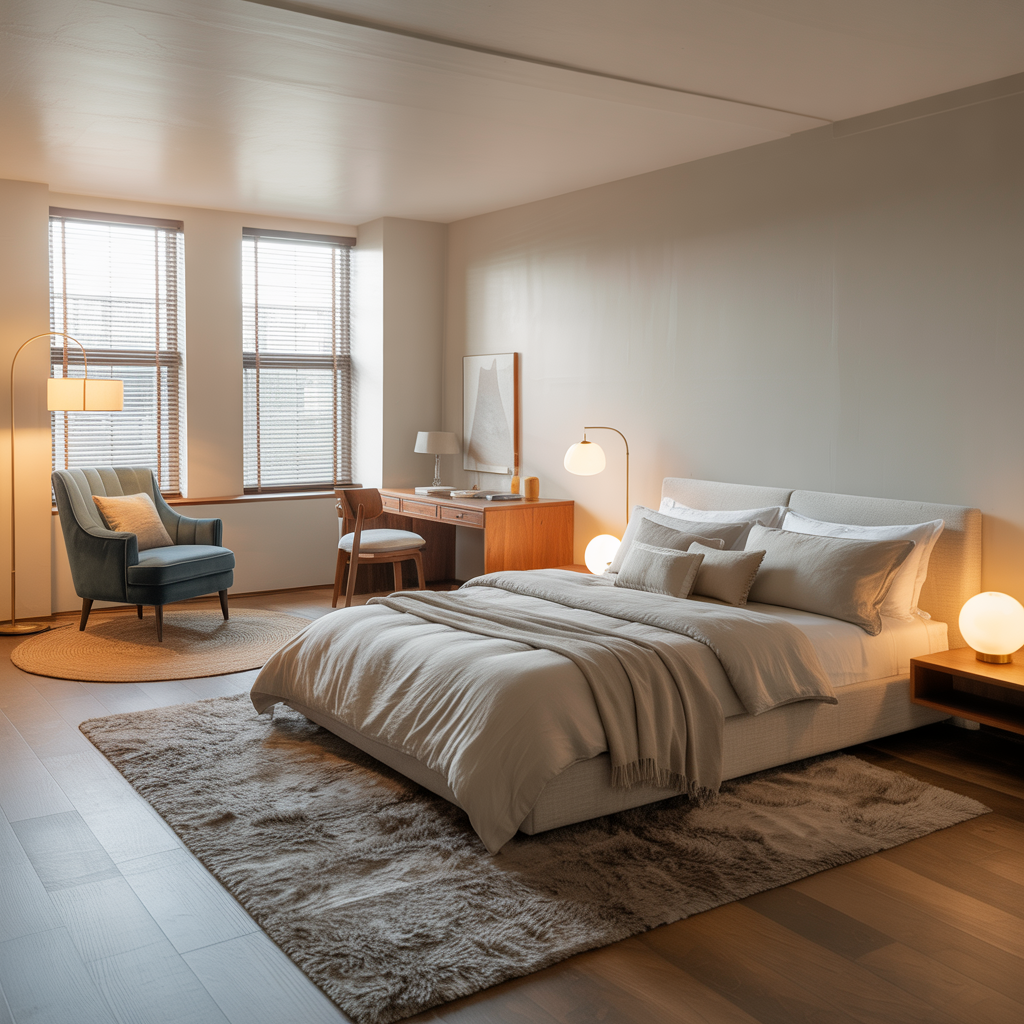
25. Express Personality Through Intentional Design Choices
Your bedroom should reflect your style while maintaining the spacious feeling you’ve worked to create. Choose one or two bold elements, perhaps a colourful piece of artwork or an interesting accent wall, while keeping other elements neutral. This approach allows your personality to shine without overwhelming your small space.
Consider incorporating meaningful items that bring joy and reflect your interests. A small collection displayed thoughtfully, photographs from travels, or handmade items can personalize your space without creating clutter. The key is editing ruthlessly, keeping only items that truly enhance your daily experience.
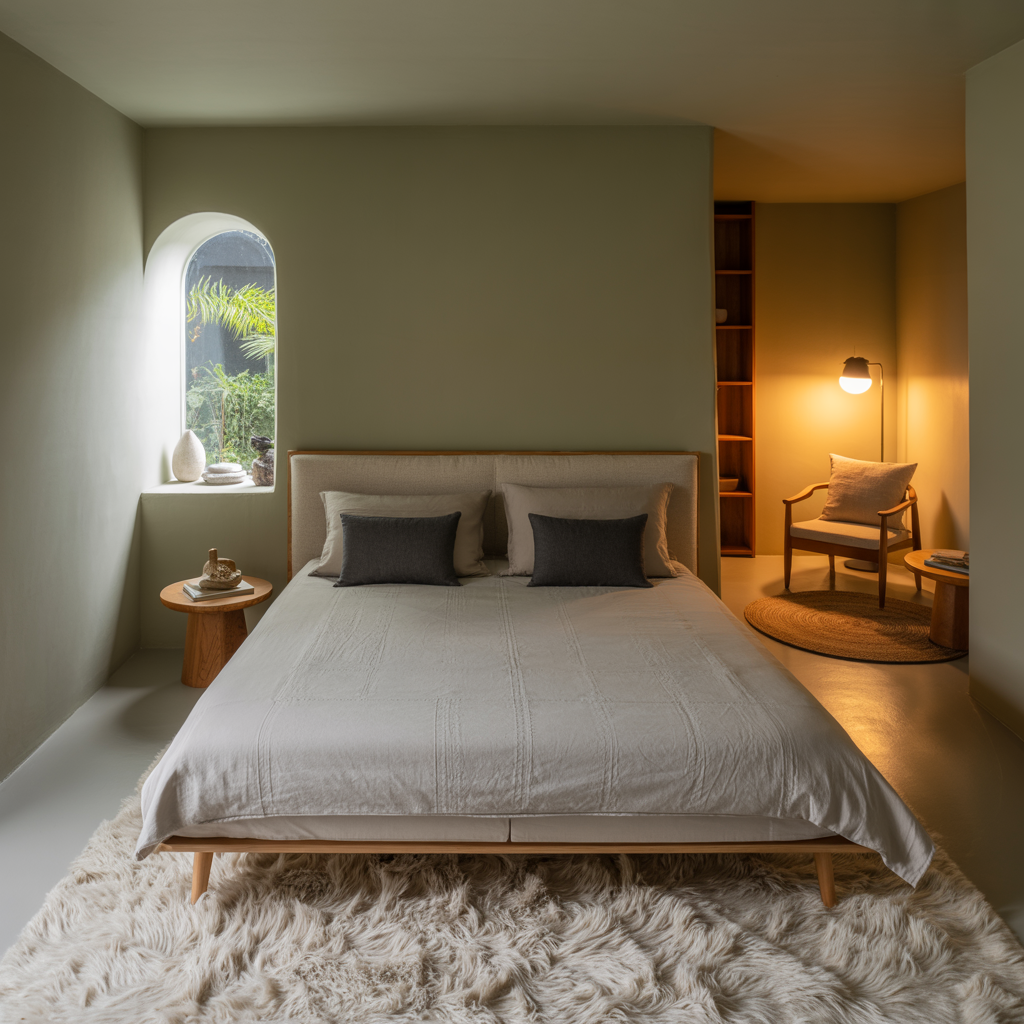
Creating Your Perfect Small Bedroom Sanctuary
Transforming a tiny bedroom into a surprisingly spacious retreat requires thoughtful planning and strategic implementation of these design principles. The most successful small bedroom makeovers combine multiple strategies, layering solutions to maximize impact while maintaining aesthetic harmony.
Start with the foundational elements furniture selection and colour palette then gradually add storage solutions, lighting improvements, and personal touches. Remember that each change should serve multiple purposes whenever possible, whether that’s adding storage, improving functionality, or enhancing the room’s aesthetic appeal.
The goal isn’t to make your bedroom feel larger through illusion alone, but to make it function better while creating a sense of openness and tranquillity that enhances your daily life. With careful planning and creative implementation of these proven strategies, your compact bedroom can become a surprisingly spacious sanctuary that perfectly balances style, comfort, and functionality.
Your small bedroom has the potential to become your favourite room in the house a perfectly curated space that reflects your personality while meeting all your practical needs. The journey from cramped quarters to spacious retreat begins with understanding that size limitations can inspire creative solutions that result in truly exceptional design.

Add a Comment